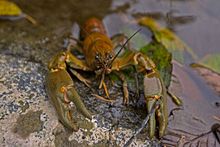Rusty crayfish
| Orconectes rusticus | |
|---|---|
 |
|
| Scientific classification | |
| Kingdom: | Animalia |
| Phylum: | Arthropoda |
| Subphylum: | Crustacea |
| Class: | Malacostraca |
| Order: | Decapoda |
| Superfamily: | Astacoidea |
| Family: | Cambaridae |
| Genus: | Orconectes |
| Species: | O. rusticus |
| Binomial name | |
|
Orconectes rusticus (Girard, 1852) |
|
The rusty crayfish (Orconectes rusticus) is a large, aggressive species of freshwater crayfish which is native to the United States. Its range is rapidly expanding in North America, displacing native crayfishes in the process: it is known to have reached New England, Ontario, Illinois, Wisconsin, Michigan, Minnesota, Iowa, Missouri, Colorado, New Jersey, New York, Pennsylvania, Maryland, and even Manitoba. It was first spotted in the mid 1960's. The rusty crayfish was first captured in Illinois in 1973, and has been collected at over 20 locations in the northern portion of the state. In 2005, O. rusticus was found for the first time west of the Continental Divide, in the John Day River, Oregon, which runs into the Columbia River.
Adult rusty crayfish can reach lengths of over 10 centimeters (4 inches), although they reach maturity at about 4.4 cm (1.7 in), and can range in color from greenish grey, to reddish brown, They can be easily recognized by two "rusty", reddish colored spots on the sides of their back and their large front claws with blank bands around the tips. Male rusty crayfish have small hook-like features on their first pair of hind legs that they use to hold onto a female while mating.
The larger size and aggressive nature of rusty crayfish that have been introduced to a body of water makes it harder for them to be preyed upon by native species of fish, which are not accustomed to crayfish fighting them back. Instead of running away like the native crayfish species do when they come in contact with a predator, the rusty crayfish will take an attack stance with its claws raised above its head, which will generally scare away most predatory fish. Additionally, adult rusty crayfish can be too large for some fish to consume. Because the rusty crayfish are able to avoid predators fairly well, their population in these new aquatic ecosystems was able to grow extremely quickly and within twenty years the rusty crayfish population had exploded and become an invasive species in the Northern United States and parts of Canada. Because these rusty crayfish populations have basically taken over the natives species' habitats and forced them out of their homes, many populations of native crayfish have experienced drastic decline over the past fifty years and the rusty crayfish has become the dominant species in much of the Midwestern United States.
...
Wikipedia

